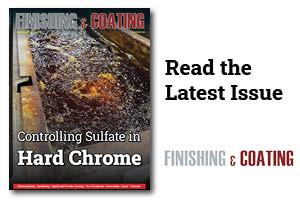A shop operated a high-speed cyanide copper plating solution about as slow as molasses.
 Frank AltmayerThe deposit looks fine, but the plating voltage is reaching 10 volts. According to the owner, the problem is related to the carbonate concentration, which exceeds 20 oz/gal of potassium carbonate.
Frank AltmayerThe deposit looks fine, but the plating voltage is reaching 10 volts. According to the owner, the problem is related to the carbonate concentration, which exceeds 20 oz/gal of potassium carbonate.
He tried to reduce the carbonates by adding calcium hydroxide but wasn’t sure he added enough because there was almost no drop in concentration. He asked me what the best way to go about this was.
Caution: This article contains procedural information that may not be suitable for your case. Be sure to verify the suitability of the information provided in this article in the laboratory, consult with the supplier of your plating solution chemicals and additives, or get professional advice before treating your specific solution.
One of the operational difficulties with cyanide plating solutions is that they tend to build up carbonates over time. Such buildup reduces conductivity (increasing the voltage required for plating, as you observed). The net result is a high-speed plating solution operating less than high speed.
Sources and Effects of Carbonates
Let’s first discuss the role and source(s) of carbonates. Carbonates are powerful buffering agents in the pH range of 10.8–11.5 and are a necessary ingredient in strike solutions used for deposition over zinc die castings. Above pH 11.5, carbonates are unnecessary nuisances. The following chemical/electrochemical reactions form the carbonates.
1. Cyanide is oxidized on the surface of the anodes if the anodes are polarized (maximum anode current density should be 4 A/dm2 or 40 A/ ft2) if insoluble anodes are used or simply by exposure to the air (which is why you never want to air-agitate a cyanide plating solution). According to Crain, two of the reactions are:
2KCN + O2 → 2KCNO
2KCNO + 2KOH + 2H2O → 2K2CO3 + 2NH3
2. The reaction between carbon dioxide from the air and either the hydroxide or water forms carbonates. In high-pH solutions:
2KOH + CO2 → K2CO3 + H2O
In lower pH solutions (pH 10–10.8):
H2O + CO2 = H2CO3
H2CO3 + KCN → KHCO3 + HCN
KHCO3 + KOH → K2CO3 + H2O
3. Carbonates are formed by hydrolysis (reaction between cyanide and water) of cyanide.
KCN + 2H2O → HCOOK + NH3
4HCOOK + 2KOH → (KCOO)2 + 2K2CO3 + 3H2
(KCOO)2 + 2KOH → 2K2CO3 + H2
According to Ref. 1, sodium carbonate should be maintained below 90 g/ L (12 oz/gal), and potassium carbonate should be kept below 120 g/L (16 oz/gal) to maintain optimum plating speed (efficiency).
The effect of high carbonate in high-efficiency solutions will reduce plating speed, reduce the bright plating range, and deliver larger-grained (less ductile) deposits.
Lowering the Carbonate Content
The literature describes several methods and reagents, but the most common methods employed by platers are freezing (exposure to approximately 30°F for several hours) for sodium carbonate and precipitation for potassium carbonate.
The precipitation method can be complicated because adding the precipitating compound almost always adds something you don’t want or need. If you add calcium hydroxide, for example, you will increase the hydroxide content of the plating solution and must readjust the other ingredients to maintain the correct ratios. If you add calcium oxide, the hydroxide rises as well, and if you add calcium cyanide, the free cyanide content increases, and so on.
Another problem to solve is that all of the compounds that can be added to precipitate carbonates are not highly soluble in either water or the plating solution. If you try to dissolve the compound and then add it to the plating solution, you dilute it far beyond normal concentrations. Last, the precipitated carbonate is quite voluminous (see Fig. 1), even if only a tiny fraction of the original carbonate concentration is removed.
All compounds mentioned in the literature are not readily available, so we tried some commonly available compounds in your solution:
- Calcium hydroxide
- Calcium nitrate
- Barium hydroxide
- Barium nitrate
- Barium acetate

Fig. 1—Precipitated carbonate; Fig. 2—Powdered barium nitrate added to the solution produces barium carbonate sludge.
Each reagent was added at a theoretical concentration that would reduce the carbonates to 7.5 oz/gal. After treatment, a Hull cell panel was plated to verify the solution's ability to produce an acceptable deposit under normal plating conditions and to determine if the treatment affected the operating plating voltage.
Experimental Results
Calcium Hydroxide: Calcium hydroxide was found to be ineffective at reducing the solution's carbonate content. Because this compound is most often mentioned as an effective way to precipitate carbonates, we were surprised at the result.
Calcium Nitrate: Calcium nitrate was found to be ineffective at reducing the carbonate content of the solution. It also eliminated the solution's free caustic, lowering the pH to 11.0. Thus, it produced a plating solution that required high voltage to deliver “normal” current density in the Hull cell.
Barium Hydroxide: We found barium hydroxide ineffective at significantly lowering the carbonate, and the treated solution required high voltage to deliver normal current densities.
Barium Nitrate: Barium nitrate treatment reduced the carbonate content to 9–10 oz/gal. The treated solution produced a reasonable deposit, with standard (low) voltages for the current density applied.
Barium Acetate: Barium acetate treatment was found to be equally effective at reducing carbonates, but the treated solution operated at a much higher voltage than would be desirable. However, this was about 50 percent of the voltage of the “as-received” solution.
Optimum Treatment: The reagent of choice in this case was barium nitrate. However, this should not be construed to mean that barium nitrate will be the best choice in all cases of carbonate removal from cyanide solutions. The following is a description of the treatment we used:
- It theoretically takes about 14 oz/gal of barium nitrate to precipitate 7.5 oz/gal of potassium carbonate.
- Barium nitrate is not highly soluble. Only about 11.6 oz will dissolve in a gal of water. The problem then becomes one of requiring so much water to dissolve the barium nitrate that the plating solution will be diluted beyond desirable concentrations. We, therefore, decided to crush the barium nitrate into a fine powder and add it as a solid to the solution, using a high level of agitation. The reaction time should be at least four hours, preferably overnight.
- The treatment produces a large amount of barium carbonate sludge (see photo). It can be settled in 4-8 hours or pressure-filtered. The treatment can then be repeated to further lower the carbonates. However, at 8-10 oz/gal, the carbonates should not be a hindrance to plating.
- We were not able to reduce the carbonate by the theoretical amount. Multiple treatments, however, can be used to lower the carbonates to any desired level.
- The treatment did not affect the concentration of the other ingredients in the plating solution.
Avoiding Carbonate Buildup
Because there is a significant emphasis on pollution prevention these days and because the treatment of carbonates produces a highly toxic waste (carbonate laced with cyanide), cyanide-based plating solutions should be operated in a manner to reduce the rate of carbonate buildup as much as possible. The following are “tips”:
- Operate at as low a hydroxide concentration as possible.
- Keep the tank covered when not in use. Crain found a 10-percent reduction in the buildup of carbonates simply by covering the tank when not in use. An idle, uncovered solution increased carbonate content at a rate of about 0.25 oz/gal per week!
- Never air-agitate or propeller-agitate a cyanide plating solution. Air agitation can produce up to 1 oz/gal of carbonates per week when operating in a high-speed plating process. Crain found that prop mixers produced the same amount of carbonates as air agitation (presumably due to cavitation), but recirculating pump agitation (eductors can be used) reduced the carbonate buildup rate by two-thirds.
- Maintain anode current density below 40 ASF (4 ASD).
- Maintain anode area by frequently checking your anode baskets and replenishing them.
- Verify the current density of each anode hook with a tong meter.
- Operate the plating solution at as low a temperature as possible. Crain found that dropping the temperature from 180F to 160F obtained a 50% drop in carbonate generation.
References
- Modern Electroplating, Frederick A. Lowenheim, ed., John Wiley & Sons, Inc.
- J.R. Crain, “Buildup and Control of Carbonates in Cyanide Copper Plating Solutions,” Plating (Jan. 1964) p. 31.
Frank Altmayer is a Master Surface Finisher, an AESF Fellow, and the technical education director of the AESF Foundation and NASF. He owned Scientific Control Laboratories from 1986 to 2007 and has over 50 years of experience in metal finishing. He received the AESF Past Presidents Award, NAMF Award of Special Recognition, AESF Leadership Award, AESF Fellowship Award, Chicago Branch AESF Geldzahler Service Award, and NASF Award of Special Recognition.



































